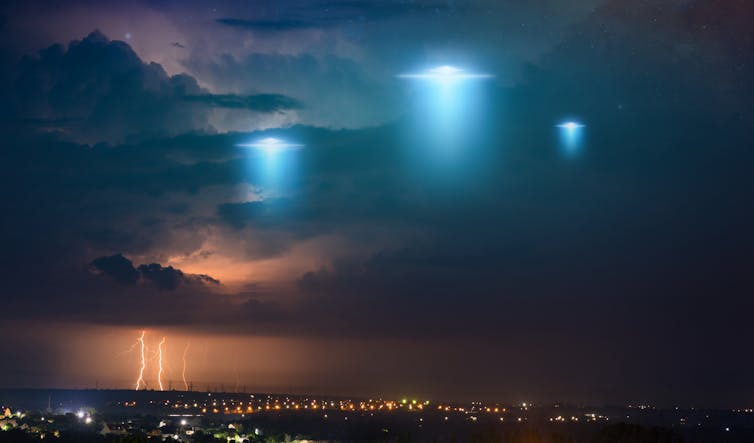Raggedstone / Shutterstock
As reports continue flying in about what were traditionally called UFOs (unidentified flying objects), Nasa is taking the topic very seriously. In fact, following the publication of a report from an independent committee of experts in fields including astronomy and aviation safety, the agency has even appointed a new director of unidentified anomalous phenomena (UAP) research.
UAP is the term Nasa now uses for UFOs. The committee was directed to gather reports of UAPs and try to understand what these mysterious events really are, including answering the question of whether or not they could be extraterrestrial in origin.
The committee held a press conference back in May, when it provided an update on its work up to that point. The study team outlined some of the common explanations for UAP sightings – which includes boats low on the horizon and high-flying balloons – as well as how many events remained truly unexplained.
Now, the committee has published the full report into what it has found, including recommendations for Nasa as its work continues. That report, which also contains Nasa’s response and plan as it moves forward, can be read in full here. I’ve also created a video about the findings.
The report makes clear that, so far, the committee has absolutely no evidence that any of the reported UAP events have any involvement from aliens. But for the reports that are still unexplained by terrestrial phenomena or aircraft, the team doesn’t rule anything out. It makes it clear that an extraterrestrial origin is unlikely, but that it has no evidence at all for what these sightings are.
The rest of the report deals with how Nasa should respond to the findings, and what it plans to do to continue this research in future.
Read more:
UFOs: what we’ll learn from the Nasa panel investigating sightings
Need for transparency
The most substantial response has been the appointment of the director of UAP research – a brand new role. Initially, when announcing this, Nasa refused to name the person in the role. It hoped to shield the new UAP director from the kind of harassment that some members of the committee have received for their involvement in the research.
However, the space agency also pledged to be completely transparent about the work on UAPs and everything it finds. This philosophy seems to have prevailed, and Nasa later announced that the new director would be Mark McInerney, a previous Nasa liaison to the US Department of Defense.

IgorZH / Shutterstock
Nasa also put forward the idea of developing a smartphone app to aid with the future reporting of UAPs. While there are hundreds of sightings available for study by the committee, one persistent problem it has faced is poor data and images.
Nasa hopes to combat this issue for future reports by using the billions of high-tech detectors around the world that most people carry everywhere. Smartphones can collect a lot of high quality information, starting with photos and videos, but they can also gather data on gravity, magnetic fields, locations and more. If the general public were open to the idea, Nasa would like to one day allow people to report sightings directly from their phones to the agency.
Another interesting revelation in the report is the prominence that Nasa believes artificial intelligence (AI) and machine learning could have as this work continues. Looking for patterns in the UAP reports – such as geographical reporting hotspots – could hold the key to finally understanding the causes of some of the events that remain mysterious.
Pattern spotting is something that humans are very good at, but sometimes the common thread is so subtle and unexpected that people can’t spot it. Luckily, AI is getting better and more powerful, and pattern spotting is one of the things it excels at. This raises the interesting possibility that AI could be essential in one day identifying the first evidence for extraterrestrial life visiting Earth. It’s not likely that we’ll identify aliens, but Nasa isn’t ruling it out.
The week that this report was released turned out to be a busy week for discussions about aliens. In Mexico, a journalist named Jaime Maussan presented alleged “mummified aliens” to the country’s Congress that he claimed had been found in Peru.
He said the specimens contained non-human DNA, but this has not yet been independently verified. In fact, much doubt has been cast over the authenticity of these corpses.
In both cases, the world must wait longer to get more concrete evidence. As more reports are collected by Nasa, it might be possible to get more clarity on what these strange objects are. And if independent testing of the Mexico specimens takes place, there might be a conclusion to this claim too.
![]()
Christopher Pattison does not work for, consult, own shares in or receive funding from any company or organisation that would benefit from this article, and has disclosed no relevant affiliations beyond their academic appointment.











